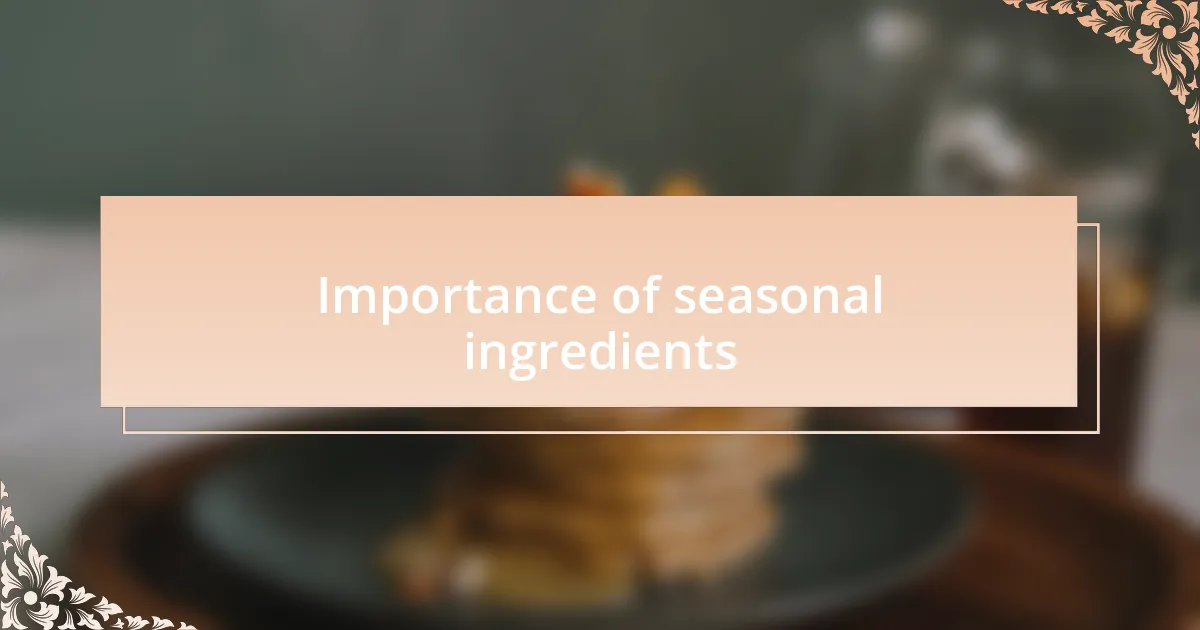Key takeaways:
- Seasonal baking enhances flavors, creates a sense of community, and connects bakers to nature.
- Using fresh, locally sourced seasonal ingredients supports farmers and inspires creativity in the kitchen.
- Seasonal recipes elevate dining experiences, turning meals into memorable gatherings.
- Successful seasonal baking involves choosing the right ingredients, embracing unpredictability, and adapting techniques to the season.

Understanding seasonal baking
Seasonal baking is all about embracing the flavors that each season brings. I remember a chilly autumn morning when I baked my first pumpkin spice loaf, and the rich, warm aroma filled my kitchen, wrapping me in a comforting embrace. Could there be a better way to celebrate the season than by incorporating these natural ingredients into our dishes?
As I work with seasonal produce, I often find myself reflecting on nature’s rhythm. For instance, spring strawberries are wonderfully sweet, and using them in a tart feels like a celebration of life renewal. Don’t you think there’s something magical about letting the seasons guide our baking choices, connecting us deeply to nature?
In my experience, seasonal baking not only enhances the taste but also creates a sense of community. I once organized a summer bake-off featuring local berries, and the joy among friends as we shared our creations was unmatched. How can we not cherish those moments when baking brings us together, highlighting nature’s bounty?

Importance of seasonal ingredients
Using seasonal ingredients not only elevates the flavors in our baked goods but also supports local farmers. I vividly recall visiting a farmer’s market just after a heavy rain, where the vibrant produce glistened, each item telling its own story of the land and season. Discovering that the blueberries I was about to bake with were picked just hours ago helped me appreciate the true essence of what fresh means. Isn’t it remarkable how much flavor can be enhanced just by choosing something that’s in season?
Moreover, there’s something quite liberating about working with what is seasonally available. One summer afternoon, I was inspired to create a refreshing peach cobbler after spotting a pile of sun-ripened peaches at my local grocery store. The decision to use them, driven by both availability and peak ripeness, yielded a dessert that exploded with juices and vibrant flavor. Have you ever wondered how much better a recipe can taste when it harnesses the freshest ingredients?
I’ve noticed that seasonal ingredients also foster creativity in the kitchen. A few winters ago, I decided to experiment with winter citrus, creating a bright lemon and rosemary cake. The combination was unexpected yet delightful, reminding me that when you work with what nature provides, you might just stumble upon a new favorite recipe. It raises an exciting question: what adventures await when we open ourselves to the changing seasons in our baking?

Seasonal recipes for brunch menus
Brunch menus benefit significantly from seasonal recipes, as they can showcase the freshest flavors available throughout the year. I remember a particularly spectacular autumn when I crafted a butternut squash and sage frittata for a weekend brunch. The rich sweetness of the squash, paired with the earthy notes of fresh sage, created a warm and inviting dish that resonated with the season. Have you ever considered how a single seasonal ingredient can transform a classic brunch staple?
As spring arrives, the explosion of vibrant greens invites delicious new possibilities. Last spring, I organized a brunch featuring a zesty asparagus and lemon risotto, beautifully vibrant on the plate and bursting with freshness. The sight alone was enough to bring smiles to my friends’ faces, and the bright lemon notes invigorated our gathering. It’s fascinating how seasonal recipes not only highlight flavors but can also elevate the dining experience into something truly special.
During the summer months, I often find myself experimenting with berries, incorporating them into light, airy pastries. One memorable dish was a blueberry-lavender scone, where the sweetness of the blueberries mingled perfectly with the delicate hints of lavender. The aroma wafting through the kitchen was intoxicating, prompting my friends to ask, “What’s baking?” It made me realize that seasonal recipes are not just about using fresh ingredients; they create memories and conversations around the table. What whispers of summer flavors will guide your next brunch menu?

Personal experiences with seasonal baking
One of my fondest memories of seasonal baking occurred during a chilly winter afternoon. I decided to try my hand at baking gingerbread cookies, their warm spices filling my home with an aroma that was both nostalgic and cozy. As I decorated each cookie with colorful icing, I couldn’t help but reflect on how much joy these small, festive treats brought to my friends and family, igniting laughter and a sense of togetherness that only winter baking can inspire.
In another instance, while prepping for a late-summer gathering, I stumbled upon a recipe for peach cobbler that called for ripe, juicy peaches. I can still recall the sheer delight when I took my first bite. The warmth of the cobbler combined with the symphony of flavors danced on my palate, transporting me back to childhood summers spent at my grandmother’s house. Isn’t it amazing how certain seasonal desserts can trigger vivid memories and emotions?
I also had the chance to experiment with pumpkin during a beautiful fall brunch. I whipped up a creamy pumpkin spice latte and paired it with pumpkin muffins, both warm from the oven. As I watched my guests savor each bite, a sense of fulfillment washed over me. Cooking with seasonal ingredients seems to foster a deeper connection with the flavors of the moment, provoking thoughts about the cycles of nature and the simple pleasures in life. Have you ever felt such a bond with the changing seasons through your own culinary creations?

Tips for successful seasonal baking
When it comes to successful seasonal baking, I find that choosing the right ingredients is essential. Recently, while experimenting with spring berries for a tart, I discovered that using fresh, locally sourced strawberries instead of frozen made all the difference. Their natural sweetness elevated the dish and reminded me of how important it is to seek out ingredients that capture the essence of the season. Have you tried playing with fresh produce in your baking?
Another tip that’s proved invaluable is to embrace the unpredictability of seasonal ingredients. Last autumn, I attempted to make an apple pie with a mix of tart and sweet apples, and though it initially seemed risky, the result was a delightful balance of flavors. This experience taught me that sometimes, taking a few chances can lead to unexpectedly delicious outcomes. What’s a baking risk you’ve taken that turned out well?
Lastly, I’ve learned that adjusting baking techniques to align with the seasons can really enhance the final product. For example, in summer, I often opt for lighter desserts that don’t rely on heavy cream or sugary frostings. My favorite was a refreshing lemon sorbet that was not only easy to make but also a perfect way to cool down. How do you adapt your baking to suit seasonal changes?

Creating a seasonal brunch menu
Creating a seasonal brunch menu starts with an understanding of the ingredients that define each season. I remember the excitement of crafting a fall-themed brunch, where I included roasted butternut squash and sage in my frittata. The combination not only offered warm flavors but also painted a beautiful autumnal palette on each plate. Have you ever thought about how colors and flavors work together on your menu?
Highlighting local produce is another key aspect I’ve discovered in my journey of seasonal menu creation. For instance, while planning a spring brunch, I sourced asparagus and rhubarb from a nearby farm, transforming them into vibrant salads and tarts. The freshness of these ingredients was palpable, sparking conversations among guests about their favorite seasonal dishes. Isn’t it fascinating how food can become a storytelling medium?
Moreover, I find that incorporating seasonal themes can elevate the overall dining experience. During my summer brunch events, I like to introduce a “Picnic Vibes” section with items like quinoa salads and berry parfaits, served in a rustic outdoor setting. This not only captures the essence of summer but engages guests in a joyful and relaxed atmosphere. How do you create an ambiance that complements your seasonal menu?